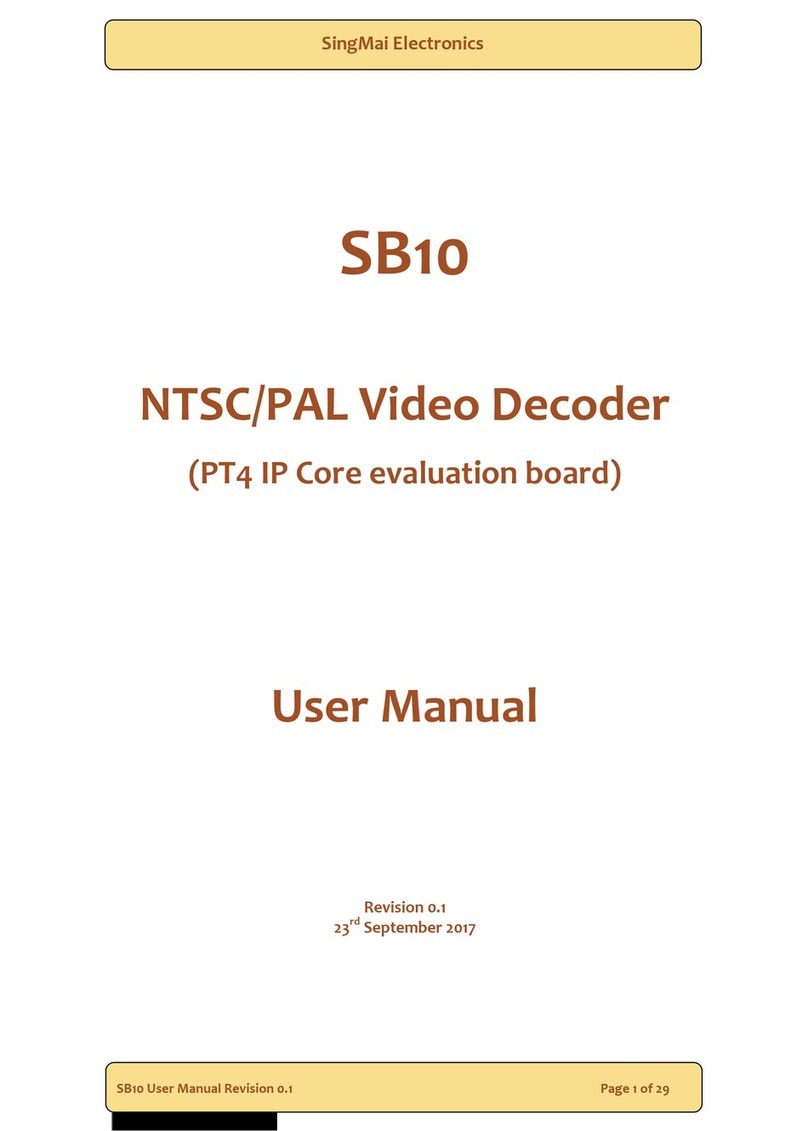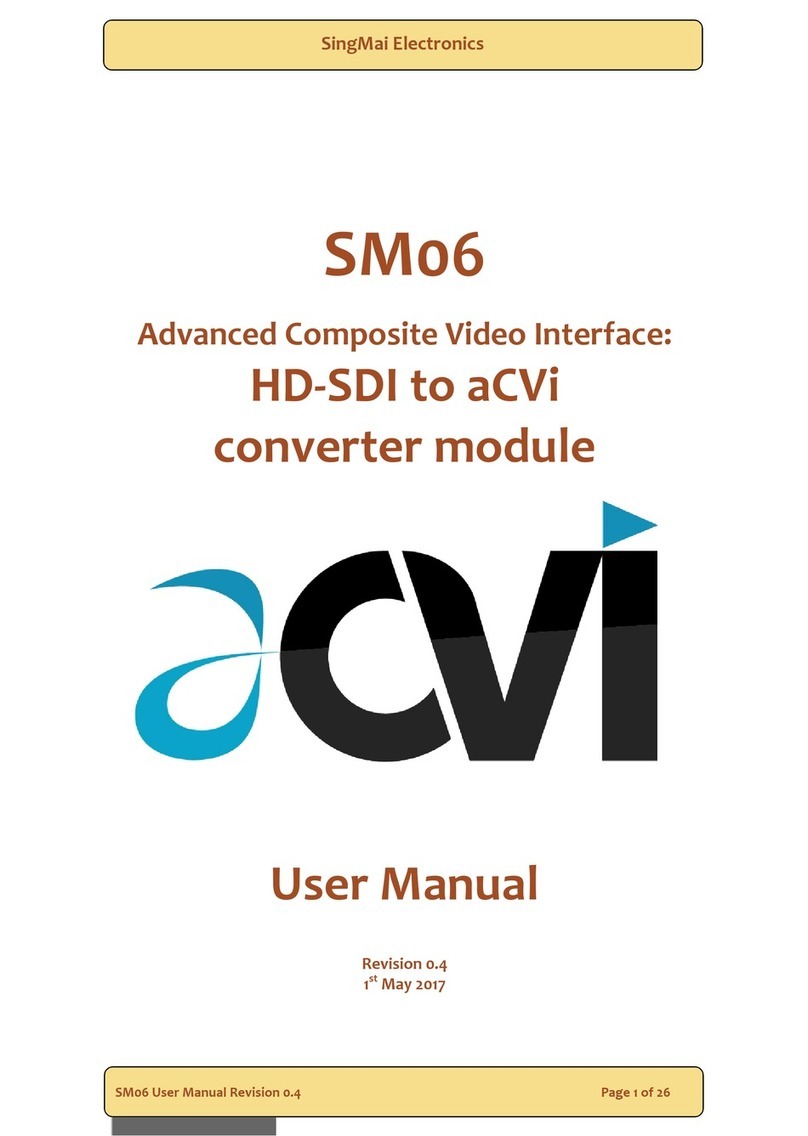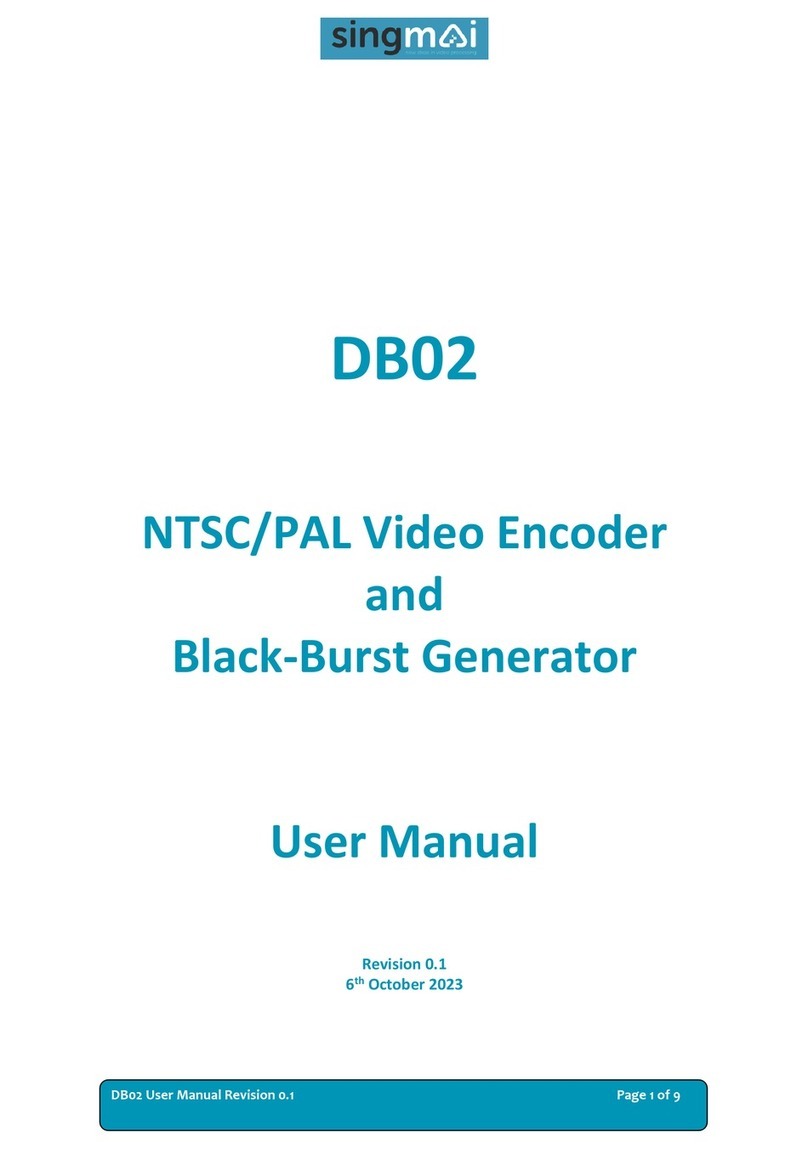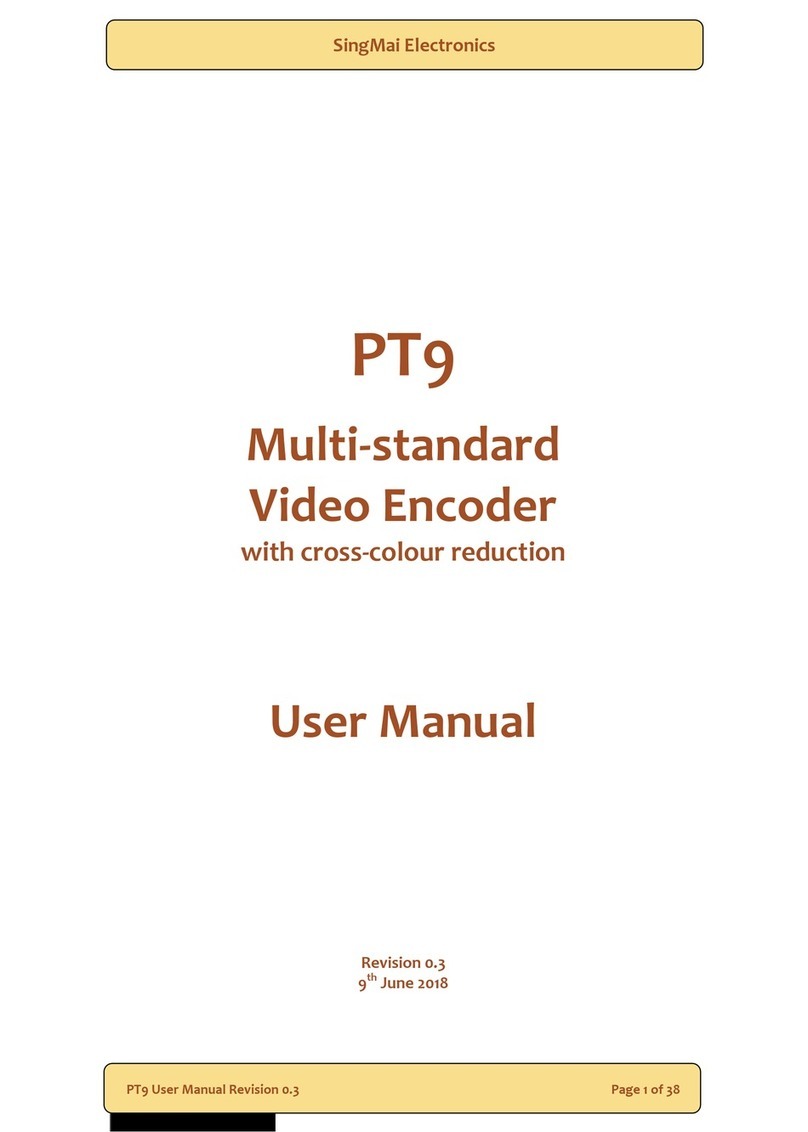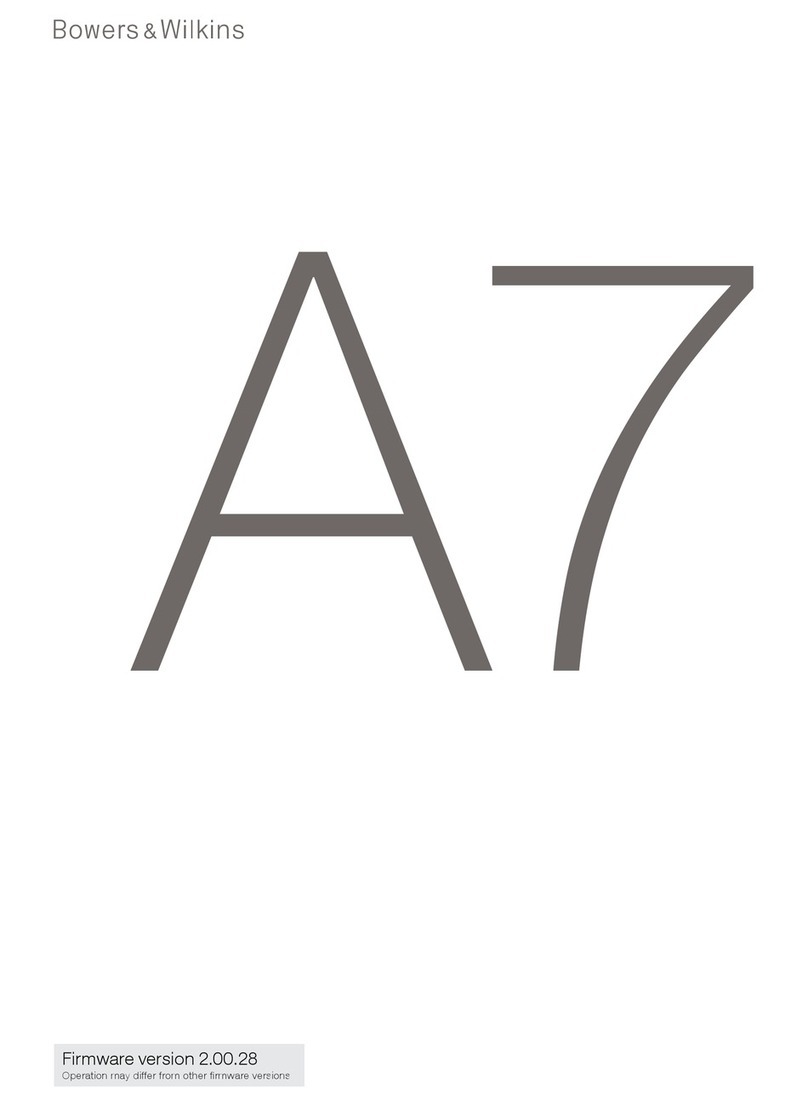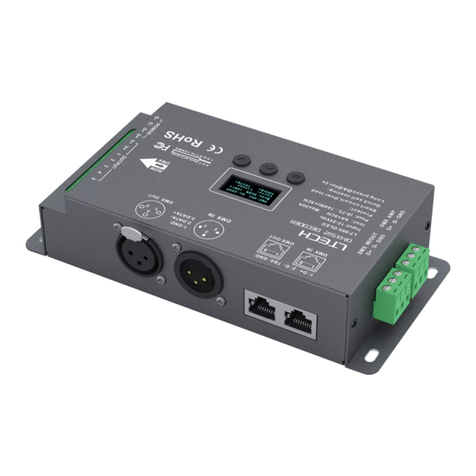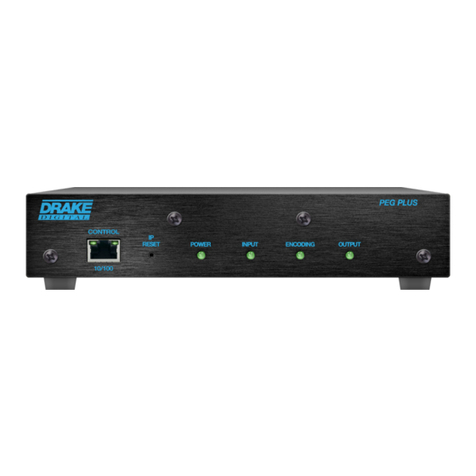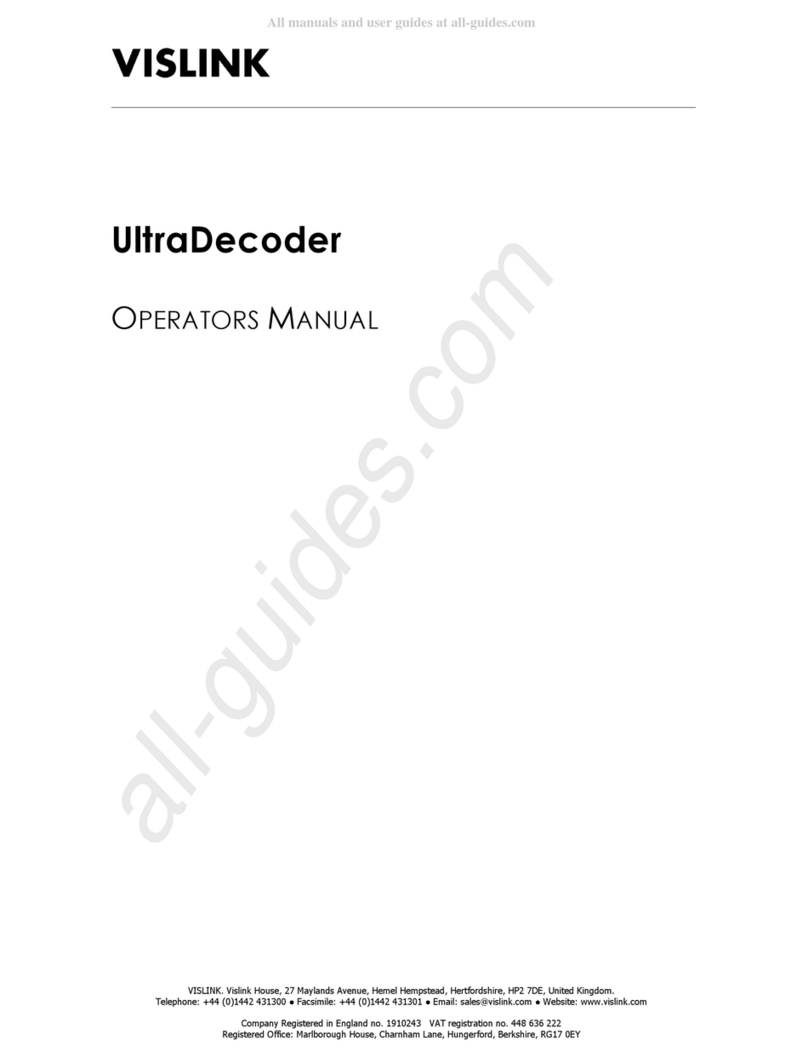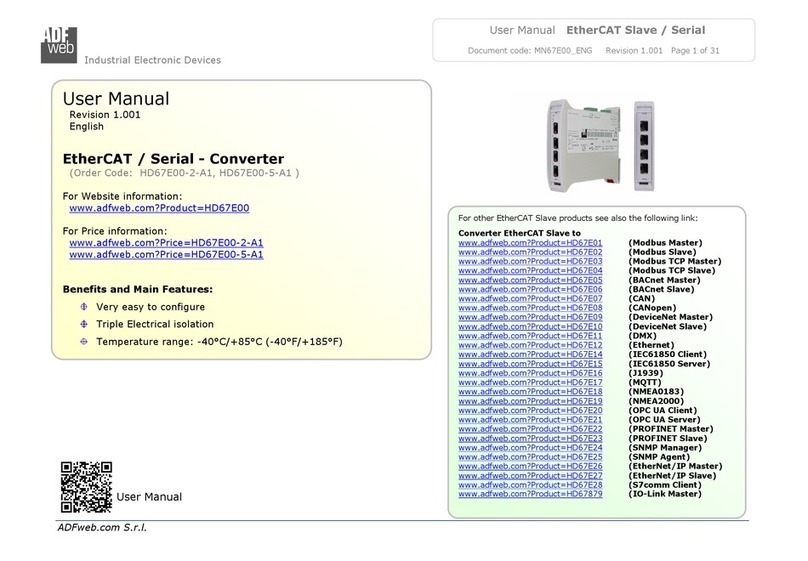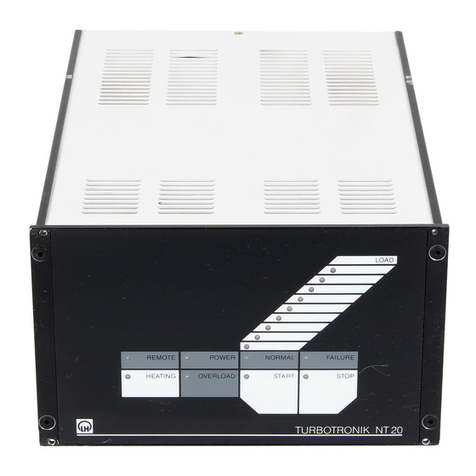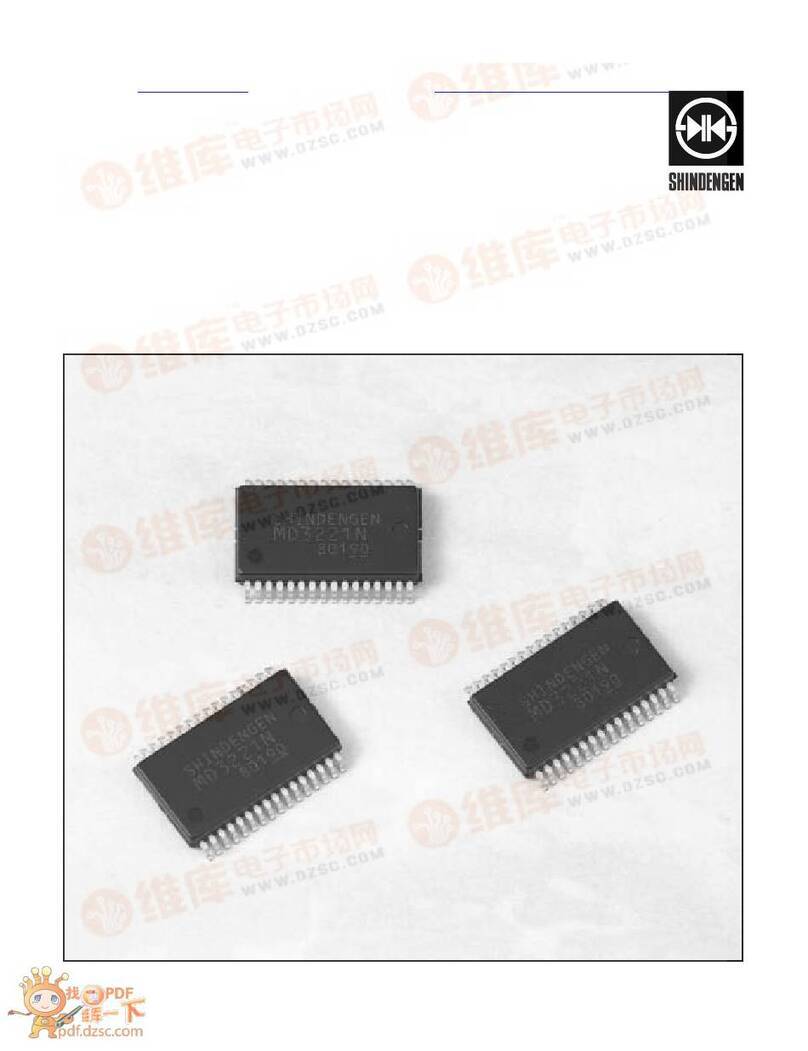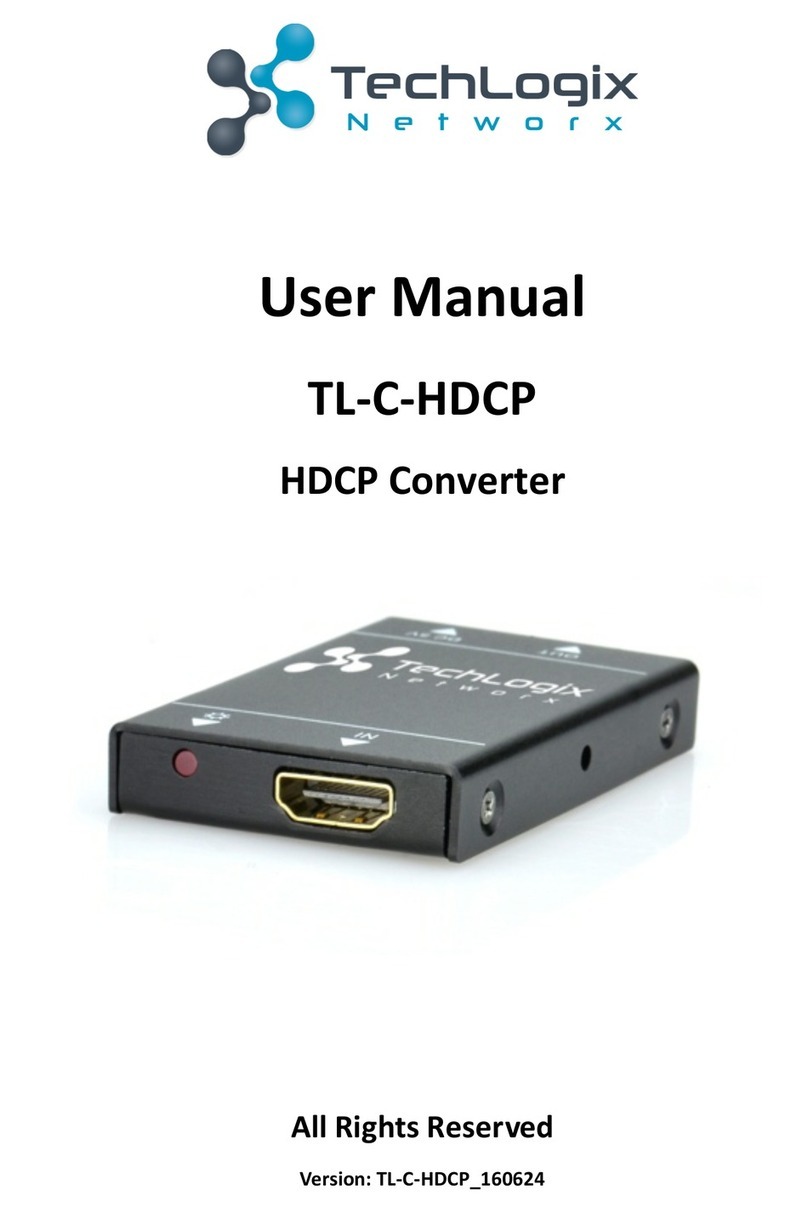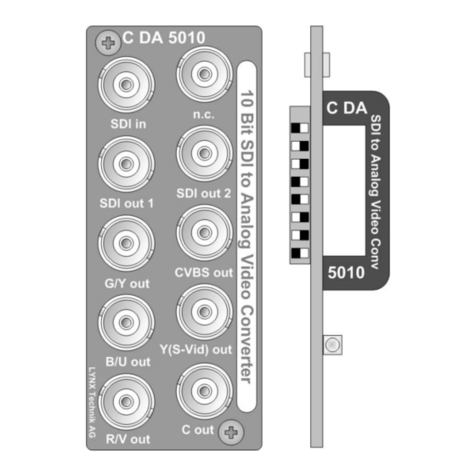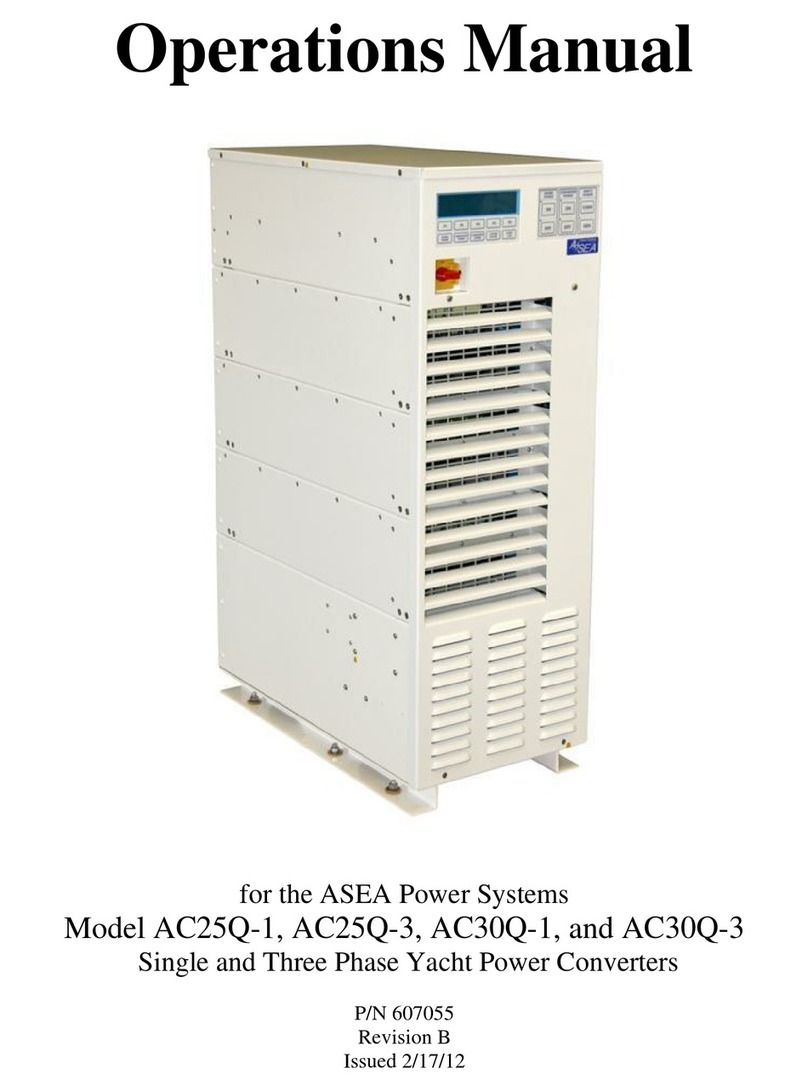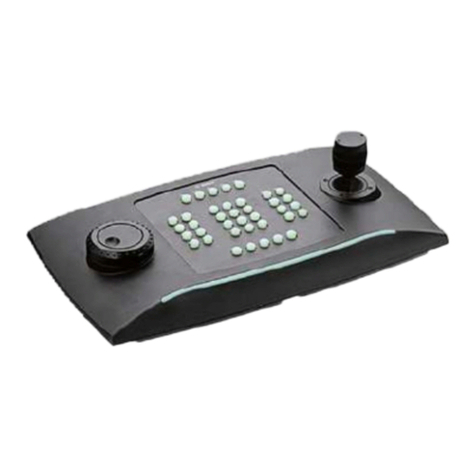Singmai Electronics SM01 User manual

1
SM01
Standard Definition Video
Encoder
and
Pattern Generator
User Manual
Revision 0.5
27th February 2015

2
Contents
Contents........................................................................................................ 2
Tables ........................................................................................................... 3
Figures..........................................................................................................3
1. Introduction ............................................................................................... 5
2. Connecting up the SM01 ..........................................................................7
3. Quick Start Guide....................................................................................10
Switch On and Control............................................................................10
Menu control...........................................................................................12
4. SM01 Patterns ........................................................................................19
75% Colour bars.....................................................................................19
100% Colour bars...................................................................................20
SMPTE Colour bars (NTSC only)...........................................................21
75% Bars + Red (PAL only)....................................................................23
Ramp......................................................................................................23
10-step staircase (960H only).................................................................24
5-step staircase ......................................................................................25
CCIR330 (PAL only)...............................................................................25
N7CMPF (NTC-7 Composite, NTSC only).............................................26
CCIR17 (PAL only).................................................................................27
2T20TPB (960H only).............................................................................28
Black.......................................................................................................28
White.......................................................................................................28
Pedestal (525 line), 50% F/F (625 line)..................................................28
Bounce....................................................................................................29
Sweep.....................................................................................................29
FCCMB (NTSC only)..............................................................................30
CCIR18 (PAL only).................................................................................30
Multi (960H only).....................................................................................31
N7CMBF (NTC-7 Combination –NTSC only)........................................32
CCIR331 (PAL only)...............................................................................32
Gamut.....................................................................................................33
Pathological (NTSC/PAL only) ...............................................................34
Bowtie (960H only) .................................................................................34
Matrix......................................................................................................35
Zone Plate ..............................................................................................36
H sweep/V sweep/Zone Pl (NTSC1280/PAL1280 only) ........................39
H Freq (NTSC1280/PAL1280 only)........................................................ 40
5. SM01 Noise generator............................................................................41
Appendix A: SM01 specification .................................................................42

3
Appendix B: Power supply specification..................................................... 60
Tables
Table 1 CVBS output specification................................................................8
Table 2 Analogue Component output Specifications ....................................9
Table 3 SDI Output Specifications.................................................................9
Table 4 SDI Input specification......................................................................9
Table 5 SM01 Patterns............................................................................... 15
Table 6 75% colour bars composite output levels...................................... 20
Table 7 100% colour bars composite levels............................................... 21
Table 8 NTSC/PAL timing specifications.................................................... 43
Figures
Figure 1 SM01 rear panel..............................................................................7
Figure 2 SM01 AC-DC converter...................................................................8
Figure 3 SM01 Front panel......................................................................... 10
Figure 4 SM01 Menu structure................................................................... 12
Figure 5 75% Component colour bar waveform......................................... 19
Figure 6 100% Colour bar waveform.......................................................... 20
Figure 7 SMPTE Colour Bar component waveform ................................... 22
Figure 8 SMPTE Reverse colour bars waveform....................................... 22
Figure 9 SMPTE Pluge waveform .............................................................. 23
Figure 10 Limit ramp waveform.................................................................. 24
Figure 11 960H 10-step waveform............................................................. 24
Figure 12 5-step staircase waveform. ........................................................ 25
Figure 13 CCIR330 waveform.................................................................... 26
Figure 14 N7CMPF (NTC-7) Component Waveform ................................. 27
Figure 15 CCIR17 Waveform ..................................................................... 28
Figure 16 Sweep Waveform....................................................................... 29
Figure 17 FCCMB Waveform ..................................................................... 30
Figure 18 CCIR18 Waveform ..................................................................... 31
Figure 19 N7CMBF Component Waveform................................................ 32
Figure 20 CCIR331 Waveform ................................................................... 33
Figure 21 Gamut Waveform ....................................................................... 33
Figure 22 Bowtie waveform........................................................................ 34
Figure 23 Bowtie markers waveform.......................................................... 35
Figure 24 Matrix test signal......................................................................... 36
Figure 25 The circular zone plate............................................................... 37
Figure 26 The zone plate horizontal frequency response. ......................... 38

4
Figure 27 Left side: The zone plate shows flickering colours at the
subcarrier frequency as the line comb fails on the zone plate image.........39
Figure 28 Hum generator............................................................................41
Figure 29 PAL horizontal timing (composite output)...................................43
Figure 30 PAL vertical timing (composite output).......................................44
Figure 31 NTSC Horizontal timing (composite output)...............................45
Figure 32 NTSC Vertical timing (composite output). ..................................46
Figure 33 NTSC 75% colour bar composite output....................................47
Figure 34 NTSC 75% colour bars vectors ..................................................48
Figure 35 PAL 75% colour bars (composite output)...................................49
Figure 36 PAL 75% colour bars vectors ..................................................... 50
Figure 37 NTSC K_Factor measurement..................................................51
Figure 38 NTSC NTC-7 Luma/Chroma delay/gain measurement..............52
Figure 39 NTSC Differential gain/phase measurement..............................53
Figure 40 NTSC noise measurement (Pedestal waveform).......................54
Figure 41 Luma frequency response (CCIR18 test signal). .......................55
Figure 42 Chrominance non-linearity (using N7C-Combination test signal).
.................................................................................................................... 56
Figure 43 SDI output 525 line format measurement...................................57
Figure 44 SDI output 625 line format measurement...................................57
Figure 45 SDI output 625 line eye pattern..................................................58
Figure 46 SDI output 625 line jitter measurement......................................59
Figure 47 AC-DC converter specification: Page 1......................................60
Figure 48 AC-DC converter specification: Page 2......................................61
Figure 49 AC-DC converter specification: Page 3......................................62

5
1. Introduction
SM01 is a video encoder and pattern generator supporting standard
definition video standards.
As a video pattern generator, SM01 can generate 15 NTSC, 15 PAL and 15
960H line based patterns, a zone plate generator, and a programmable
12MHz maximum horizontal frequency sweep. These are output as
simultaneous SDI (SMPTE-259M –NTSC/PAL only), YPbPr component,
NTSC-M/J/443 or PAL-M/60 (for 525 line standards) or PAL-BG/I or PAL-N
(for 625 line standards) or 960H (NTSC or PAL) or 1280H (NTSC or PAL –
zone plate, vertical and horizontal sweep only) formats.
Patterns available include:
75%/100%/SMPTE/Bars+Red colour bars
Black/White/50% grey flat fields
2T, 20T and Pulse bar
CCIR17/18/330 and 331
FCC Comp and FCC MB
N7C MBF and N7C MPF
Ramp
Multi-burst
Horizontal (up to 12MHz) and Vertical Sweeps
5/10 step linearity
Pathological (SDI test)
Gamut
Bowtie
Circular Zone Plate
In addition programmable amplitude noise may be added to the CVBS
pattern output. Noise can be 50Hz or 60Hz hum and/or white noise.
As a video encoder SM01 accepts 525 or 625 line SMPTE-259M inputs
which it encodes to simultaneous SDI (SMPTE-259M), YPbPr component
and NTSC-M/J/443, PAL-M/PAL-60 (525 line standards) or PAL-BG/I, PAL-
N (for 625 line standards). Again noise may be added to the CVBS output.

6
Controls provided include:
CVBS amplitude
CVBS Luma amplitude
CVBS Chroma amplitude
CVBS Burst amplitude
CVBS Sync amplitude
CVBS Black level
NTSC Hue (Chroma phase)
CVBS subcarrier frequency
YPbPr Luma amplitude
YPbPr Chroma amplitude
YPbPr Sync amplitude
YPbPr Black level
SM01 is powered by a universal input power supply and controlled with a
simple and intuitive selection menu.

7
2. Connecting up the SM01
All connections to the SM01 are made via the rear panel: see Figure 1.
Figure 1 SM01 rear panel.
The AC-DC converter connects to the left hand jack. The SM01 input is
protected against reverse polarity. The converter supplied with the SM01 is
a model MW173KB manufactured by SL Power Electronics Corp. and
provides 9VDC at 3A and accepts AC inputs from 100-240VAC. Connect
the supplied power cord to the AC-DC converter and output DC of the
converter to the 9VDC Power In input of the SM01.

8
Figure 2 SM01 AC-DC converter
A full specification for the supplied AC-DC converter may be found in
Appendix B.
The SM01 provides both analogue and digital component outputs for
connecting to the equipment under test.
The CVBS (NTSC/PAL) output is connected to the BNC, ‘CVBS Out’. The
specification for the output is shown in Table 1. The composite output
specification is detailed in Appendix A.
Parameter
Specification
Comments
Connector Type
BNC
Output impedance
75Ω
Output return loss
>30dB
0-5MHz
CVBS output level
1.0V pk.pk
Nominal peak Y to sync tip
for 100% colour bars input
Table 1 CVBS output specification.

9
The analogue component outputs are connected to the BNCs, ‘Y Out’, ‘Pb
Out’and ‘Pr Out’. The specification for the outputs is shown in Table 2. The
component output specification is detailed in Appendix A.
Parameter
Specification
Comments
Connector Type
BNC
Output impedance
75Ω
Output return loss
>30dB
0-5MHz
Y output level
1.0V pk.pk
Nominal 100% colour bars
input
Cb/Cr output levels
700mV pk-pk
Nominal 100% colour bars
input
Table 2 Analogue Component output Specifications
The serial digital interface (SDI) output is connected to the ‘SDI Out’BNC
and its specifications are shown in Table 3.
The SDI output conforms to the SMPTE-259M specification. The SDI output
specification is detailed in Appendix A.
Parameter
Specification
Comments
Connector Type
BNC
Output impedance
75Ω
Fixed termination
Output return loss
>15dB
50Hz-270MHz
Output level
800mV pk-pk ± 10%
Jitter
<0.2UI
Table 3 SDI Output Specifications
The serial digital interface (SDI) input (only used in encoder mode) is
connected to the ‘SDI In’ BNC and its specifications are shown in Table 4.
The SDI input conforms to the SMPTE-259M specification.
Parameter
Specification
Comments
Connector Type
BNC
Input impedance
75Ω
Fixed termination
Input return loss
>15dB
50Hz-270MHz
Input level
800mV pk-pk
Nominal
Table 4 SDI Input specification.

10
3. Quick Start Guide
Switch On and Control
Connect the AC-DC converter 9VDC cable into the rear panel power in
socket. Connect the AC supply to a local AC supply between 110-240VAC.
The Standby LED should light. Push the Adjust control and the unit will
switch on and the welcome message will be displayed (SingMai SM01).
To switch off the SM01 push the Adjust control again.
The front panel of the SM01 is shown in Figure 3.
Figure 3 SM01 Front panel.
There are just two controls for the SM01. The right hand control (Adjust)
switches the unit between On and Standby by pushing it whilst also
adjusting the value of parameters by rotating the knob left or right. The
central switch (Select) selects the chosen menu parameter and switches
preset parameters between, for example, on and off.
After the welcome message (‘SingMai, SM01’) is displayed for a few
seconds the LCD display will show the available top level menus. A left
hand arrow indicates which menu is ‘active’. Rotating the Adjust control will
show all the available menus; after the last of the menus an up arrow is
shown.
To select a menu ensure the left arrow is by the side of the required top
level menu and press the Select button. Those menu options will then be
displayed.

11
To change a parameter within the lower menu choices choose the required
item by aligning the left arrow with it and press the Select button. The
parameter will either toggle between the available options (e.g. On or Off)
or will show a menu bar where to can select more options via the Adjust
control. Once you have chosen the setting you require press the Select
button to return to the menu choices.
The Adjust control is also used to set the parameter values. Once set the
required value, press the Select button to retain that value and return to the
menu.
To return to the top level menu scroll down the menu choices using the
Adjust control; the last one before the up arrow will show Exit. Select this
by pressing the Select button and you will return to the top level menus.

12
Menu control
The complete menu structure is shown in Figure 4.
Figure 4 SM01 Menu structure.

13
The following is a brief description of the menu functions.
SDI in:
Pattern (Encoder)
Each button press toggles between the internal patterns (Pattern –default
value) and the serial digital (SDI) input (Encoder).
(Note: the SDI input is not operative for the 960H or 1280H standards.)
Exit
Returns to the top level menus.
Stand’d (Standard):
In Encoder mode the SDI input standard must match the output
standard selection. (i.e. if the SDI input is 625 line standard, selecting
NTSC-M/J/443/PAL-60 or PAL-M will result in corrupted outputs).
NTSC-M
Forces NTSC-M output standard for the composite output and 525 line
standard for the YPbPr and SDI outputs. (Default value)
NTSC-J
Forces NTSC-J output standard for the composite output and 525 line
standard for the YPbPr and SDI outputs. (NTSC-J is the Japanese version
of NTSC, which has no setup and different output levels to NTSC-M).
NTSC443
Forces NTSC443 output standard for the composite output and 525 line
standard for the YPbPr and SDI outputs. (NTSC-443 is a playback
‘standard’ which has NTSC timing characteristics with a 4.433MHz PAL
subcarrier frequency).
PAL-BG
Forces PAL-BG output standard for the composite output and 625 line
standard for the YPbPr and SDI outputs.
PAL-I
Forces PAL-M output standard for the composite output and 525 line
standard for the YPbPr and SDI outputs.

14
(Note the difference between PAL-BG and PAL-I is only the front porch
value).
PAL-N
Forces PAL-N output standard for the composite output and 625 line
standard for the YPbPr and SDI outputs.
PAL-60
Forces PAL-60 output standard for the composite output and 525 line
standard for the YPbPr and SDI outputs. (PAL-60 has NTSC timing
characteristics but with a PAL 4.43 subcarrier frequency and PAL phase
alternate line switching).
NTSC960
Forces NTSC-M output standard for the composite output and 525 line
standard for the YPbPr outputs. (Note the 960H sampling frequency is
36MHz).
PAL-960
Forces PAL-BG output standard for the composite output and 625 line
standard for the YPbPr outputs. (Note the 960H sampling frequency is
36MHz).
NTSC128
Forces NTSC-M output standard for the composite output and 525 line
standard for the YPbPr outputs. (Note the 1280H sampling frequency is
54MHz).
PAL1280
Forces PAL-BG output standard for the composite output and 625 line
standard for the YPbPr outputs. (Note the 1280H sampling frequency is
54MHz).
Exit
Returns to the top level menus.
The specifications for the standards are shown in Appendix A.

15
Pattern:
Selects the output pattern when in ‘Pattern’ mode. (In ‘Encoder’ mode the
pattern menu cannot be selected.)
The patterns available depend on the standard selected. Table 5 lists the
patterns available for each standard. A full description of the patterns can
be found in Chapter 4.
Table 5 SM01 Patterns.

16
P’meter (Parameter):
Note that some combinations of the parameter settings can give invalid
outputs and may result in clipping of the signal.
CVBS
Adjusts the output amplitude of the composite video output. Default value is
100% (gain of 1). Range is 0-130%.
CVBS-Y
Adjusts the output amplitude of the luma component of the composite video
output. Default value is 100% (gain of 1). Range is 0-130%.
CVBS-C
Adjusts the output amplitude of the chroma component of the composite
video output. Default value is 100% (gain of 1). Range 0-130%.
Burst
Adjusts the output amplitude of the colour burst of the composite video
output. Default value is 100% (gain of 1). Range 0-130%.
CVBS-S
Adjusts the output amplitude of the synchronizing signals of the composite
video output. Default value is 100% (gain of 1). Range is 0-130%.
CVBS-B
Adjusts the output black level of the composite video output. Default value
is pedestal value for NTSC-M or 0mV for other standards). Default value is
0 (offset of 0mV). Range is ±100.
NTSCHue
Adjusts the phase of the chroma component (hue) for composite video
output (NTSC-M/-J/-443 only). Default value is 0deg. Range is ±180deg.
FSc
Adjusts the frequency of the subcarrier for the composite video output.
Default value is 0Hz. Range is ±400Hz.
YPbPr-Y
Adjusts the output amplitude of the luma (Y channel) of the component
YPbPr analogue video output. Default value is 100% (gain of 1). Range is
0-130%.

17
YPbPr-C
Adjusts the output amplitude of the chroma (Pb/Pr) of the component
YPbPr analogue video output. Default value is 100% (gain of 1). Range is
0-130%.
YPbPr-S
Adjusts the output amplitude of the synchronizing signals of the component
Y analogue video output. Default value is 100% (gain of 1). Range is 0-
130%.
YPbPr-B
Adjusts the black level value of the luma component of the component
YPbPr analogue video output. Default value is 100 (offset of 0mV). Range
is ±100.
Exit
Returns to the top level menus.
Noise:
Y Noise
Selects a sub menu which allows control of the amplitude of white noise
injected into the Y output channel of the CVBS analogue output only. The
range of the control is from 0 (off –default value) to 100 (maximum noise).
A fuller description of the noise generator may be found in Chapter 5.
Video (V+Sync)
The injected noise (white noise) is limited to the active video portion of the
analogue output waveform (Video –default value) or the entire waveform
(V+Sync).
Hum
Selects a sub menu which allows control of the amplitude of hum injected
into the CVBS analogue output. The range of the control is from 0 (off –
default value) to 100 (maximum hum). A fuller description of the noise
generator may be found in Chapter 5.
Hum60Hz (Hum50Hz)
Selects frequency of the hum (50Hz or 60Hz).
Exit
Returns to the top level menus.

18
Setup:
B’light
Controls the brightness of the front panel LCD backlight. Default value is ‘4’.
VITSOn (VITSOff)
Inserts the CCIR17, CCIR18, CCIR330 and CCIR331 test patterns onto
lines 17, 18, 330 and 331 respectively of the PAL output standard if enabled
(VITSOn) or the N7CMBF and N7CMPF onto line 17 of fields 1 and 2
respectively of the NTSC standard. Default value is VITS on.
C’maOn (C’maOff)
Turns off the chroma component of the CVBS output and sets the Pb/Pr
outputs of the analogue component output to blanking level if set (C’maOff).
Default value is chroma on (C’maOn).
Exit
Returns to the top level menus.

19
4. SM01 Patterns
Below is a detailed description of each of the SM01 patterns.
(Note: The NTSC/PAL 1280H standards only provide a set of
programmable frequency sweeps that allow the performance of this
standard’s extended luma bandwidth to be measured. The description of
these patterns are at the end of this chapter.)
75% Colour bars
75% colour bars are used for measuring insertion gain, chroma level and
chroma gain and for monitor alignment. The SM01 generates full frame
75% saturated colour bars with a 100% white bar reference and 7.5 IRE
setup (for the NTSC-M/PAL-M composite output only). The colour bar
sequence is white, yellow, cyan, green, magenta, red, blue and black.
Figure 5 75% Component colour bar waveform.
The output levels for the composite bar waveform are shown below.
mV
NTSC-M(J) / PAL-M 100/7.5/75/7.5
PAL / PAL-N 100/0/75/0
Luminance
Chrominance
Luminance
Chrominance
White
714.29(714.29)
0.00(0.00)
700.00
0.00
Yellow
492.62(474.64)
443.34(479.29)
465.15
470.50
Cyan
400.94(375.54)
626.69(677.50)
368.03
663.81
Green
344.45(314.46)
585.18(632.63)
308.18
620.09
525 line
75%Colour Bars
0
100
200
300
400
500
600
700
800
900
1000
0100 200 300 400 500 600 700 800
YPixel No.
10 bit value
0
100
200
300
400
500
600
700
800
900
050 100 150 200 250 300 350 400
Cb/Cr Pixel No.
Y Value (Dec)
Cb Value (Dec)
Cr Value (Dec)

20
mV
NTSC-M(J) / PAL-M 100/7.5/75/7.5
PAL / PAL-N 100/0/75/0
Luminance
Chrominance
Luminance
Chrominance
Magenta
258.22(221.25)
585.18(632.63)
216.83
620.09
Red
201.73(160.18)
626.69(677.50)
156.98
663.81
Blue
110.06(61.07)
443.34(479.29)
59.85
470.50
Black
(Setup)
53.57(0.00)
0.00(0.00)
0.00
0.00
Table 6 75% colour bars composite output levels.
100% Colour bars
100% colour bars are used for measuring insertion gain, chroma level and
chroma gain and for monitor alignment. The SM01 generates full frame
100% saturated colour bars with a 100% white bar reference and 7.5 IRE
setup (for the composite output only). The colour bar sequence is white,
yellow, cyan, green, magenta, red, blue and black.
Note that 100% NTSC colour bars will cause clipping in the transmitter and
they are therefore only used within a studio ‘closed system’.
Figure 6 100% Colour bar waveform.
The output levels for the composite bar waveform are shown below.
525 line 100%Colour bars
0
100
200
300
400
500
600
700
800
900
1000
0100 200 300 400 500 600 700 800
YPixel No.
10 bit value
0
200
400
600
800
1000
1200
050 100 150 200 250 300 350 400
Cb/Cr Pixel No.
Y Value (Dec)
Cb Value (Dec)
Cr Value (Dec)
Table of contents
Other Singmai Electronics Media Converter manuals
